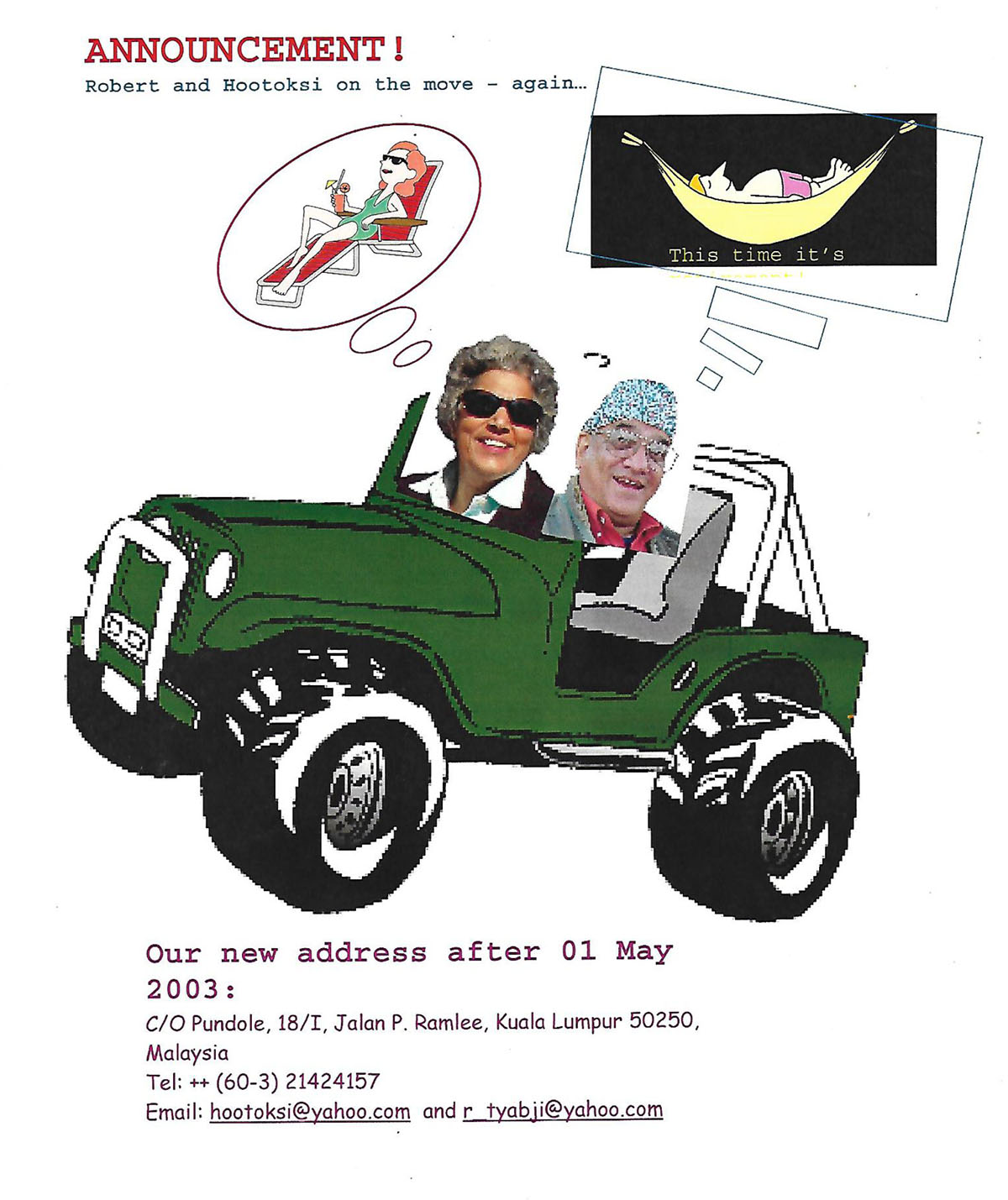Our Life and Times in Nepal, 2001 - 2003
Background and Introduction
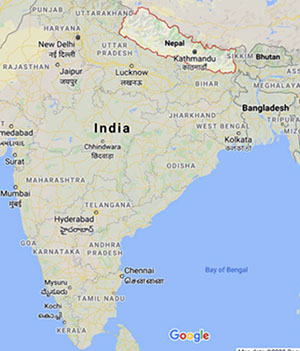
Nepal is located largely in the Himalayas but also encompasses parts of the Indo-Gangetic Plain, and is landlocked. It is is surrounded by China in the north, India in the south, east and west, Bangladesh is very near its southeastern tip, and Bhutan is separated from it by the Indian state of Sikkim. Nepal has a diverse geography; fertile plains, sub-alpine forested hills, and eight of the world's ten tallest mountains, including Mount Everest. Kathmandu is the capital and the largest city. Nepal is a multi-ethnic country with Nepali as the official language.
Hinduism is the predominant religion. Gautama Buddha was born in Lumbini in southern Nepal. Tibetan culture is dominant in parts of northern Nepal bordering Tibet while the centrally located Kathmandu Valley is culturally intertwined with India, but with its own distinct art and architecture. The Himalayan stretch of the ancient Silk Road was controlled by the valley's traders. The Shah Dynasty (aka the Gorkha Kingdom) who ruled between 1559 and 1768 unified Nepal as the Kingdom of Nepal and later formed an alliance with the British Empire under its Rana Dynasty of Premiers. The country was never colonized but served as a buffer state between Imperial China and British India. In May 1991, Nepal held its first parliamentary elections and in February 1996, the Maoist parties declared a People's War against the monarchy and the elected government.
Now, nearly 20 years later (2000), it is interesting to look back on Nepal's tumultuous political history - see "A reflection on Nepal’s Path to a Republic" by Pawan K Singh, Himalaya Comprehensive Research.
During our tenure in Nepal, the underground Maoist rebels were operating quite openly, visiting peoples' homes to demand 'donations' and kidnapping entire busloads of young Nepalis to train as communist fighters. Demonstrations, random bombings, riots and closures of entire localities in Kathmandu and other towns were commonplace.
Getting there
This posting was to be my last with UNICEF as I was just a couple of years from 60, the UN's mandatory retirement age. The move from the Tanzania Country Office to the UNICEF Regional Office for South Asia in Nepal was a promotion but it was also a shift from field based work to team-based regional management responsibilities, which were not much to my liking and operating style. Nevertheless, it was a good experience and one which allowed me more time to contemplate and plan for my impending retirement. Besides, it gave Hootoksi and me ample opportunities to explore and enjoy beautiful Nepal.
Once we had decided to start our retirement in Malaysia where Hootoksi's parents had been living since the 1970s, it occurred to me that it would be a thrilling, once-in-a-lifetime experience to drive from Kathmandu to Kuala Lumpur. I knew that another opportunity to drive through Nepal, parts of eastern India, Myanmar and Thailand would likely never present itself again. Our large and powerful diesel Nissan Patrol was the perfect vehicle for such an adventure and so the idea morphed into a dream and nearly became an obsession. I mooted the idea with the Myanmar Ambassador who also became quite enamoured with it. He took it upon himself over the next three months to advocate on my behalf with his government in Yangon, but sadly in the end, the Myanmar government declined permission for the trip due, they said, to security risks along the way. So I sold the vehicle and we flew to KL.
Our Home in the Clouds
Hootoksi Tyabji, Dar es Salaam and Kathmandu, 2001 and 2003
We've spent over six happy years in Tanzania and the time had finally come to bid farewell to our friends and our lives here, and to move, in March 2001, to Nepal.
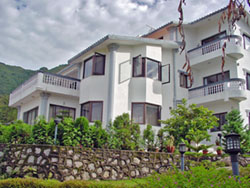
The house was partially furnished, and as our container arrived a few weeks after we did, we camped in our new home with a few basics and began to enjoy its ambiance right away!
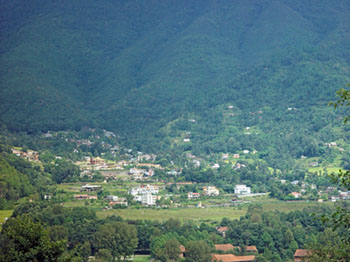 The area was Budhanilkantha in the northern-most part of the city, in the foothills of the Shivapuri National Park. The Park is an important water catchment area for the entire Kathmandu valley. On a good day, from our house we could see the forests and the Shivapuri peak (8,963 ft).
The area was Budhanilkantha in the northern-most part of the city, in the foothills of the Shivapuri National Park. The Park is an important water catchment area for the entire Kathmandu valley. On a good day, from our house we could see the forests and the Shivapuri peak (8,963 ft).
Budhanilkantha is a municipality in the Kathmandu District that was formed in December 2014 by merging nine villages under a central administration. This meant that our community was made up of farmers, wealthier Nepalis like our landlord, an airline pilot and his wife, a businesswoman, who bought land and built their dream homes, some mansions, others simpler. There was only one main road that led to the top of the hill and it was unpaved and very difficult to traverse, especially when it rained! It often resembled a river with stones, boulders and potholes that had to be avoided. We were fortunate to own a Nissan Patrol 4WD car, driven for the most part by our excellent driver Ram Bahadur. He seemed to know exactly how to avoid the puddles with huge potholes underneath, and the large boulders which could wreck a car if one hit them. Ram Bahadur cruised up and down that road with great aplomb as if it were smooth as silk!
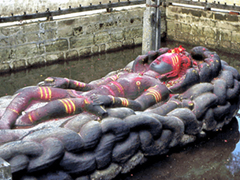 At the start of that “road” and to one side, was the famous Budhanilkantha Temple which housed a 5th century image of lord Vishnu.
At the start of that “road” and to one side, was the famous Budhanilkantha Temple which housed a 5th century image of lord Vishnu.
“Carved from a single block of black basalt stone of unknown origin, the Budhanilkantha statue is over 4 ft in length and lies in a reclining position inside a recessed tank of water which represents the cosmic sea. Called the Sleeping Vishnu, the statue depicts the deity reclining on the twisting coils of the cosmic serpent, Shesha” - adapted from Martin Gray in the World Pilgrimage Guide.
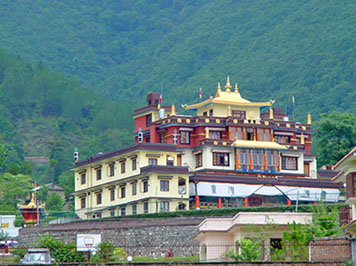 Above our house was the beautiful Buddhist Lhundrup Choling Monastery and we loved the sound of the bells and gongs, never overpowering, just softly carried over on the wind!
Above our house was the beautiful Buddhist Lhundrup Choling Monastery and we loved the sound of the bells and gongs, never overpowering, just softly carried over on the wind!
Below and on one side was a vacant field where a farmer grazed his ponies, a pleasure to watch; and all around us were wooded mountains. Scattered between the large homes were traditional Nepali farmhouses with small land holdings where agricultural activities were carried out every day.
Our landlords Nima and Dikila Lama had built the house for their retirement and we were their first tenants. The road leading up to the house was dirt with potholes and rocks strewn around and it was very narrow. Ours was the last house on that lane.
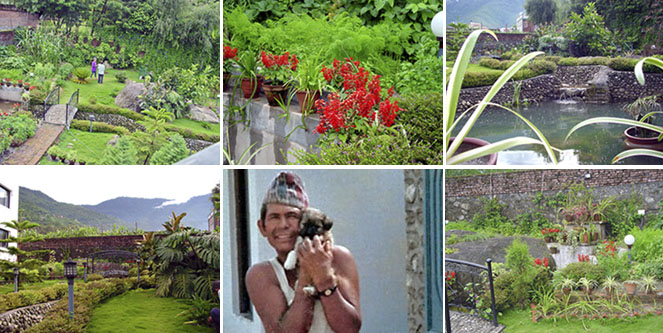
The house was set in an exquisite garden which was on three levels with its own spring, the source of our water supply. There was a stream with two small wrought iron bridges and a pond at the bottom and a small vegetable patch at the top where Kancha, our gardener (see pic) did his best to grow things but never really succeeded! The rest of the garden was lawn and flowers with wrought iron furniture placed where you could sit and enjoy the views. We had beautiful Japanese grass which was spongy and bouncy and felt wonderful on the bare soles of our feet!
There were three floors and we had great big glass windows and doors, so the garden and the views outside were visible from every room! This was especially wonderful in the winter when the strong sun streamed inside and kept the house warm. On the ground floor were the living and dining areas, and the kitchen. A grand stairway with a beautiful oak banister led to the two floors above, our room was on the top with a magnificent view, it truly was “the Room with a View!” Each floor had its own balcony, and sitting out there in the winter was pure heaven! Every time I walked up and down those stairs, I felt like a queen!
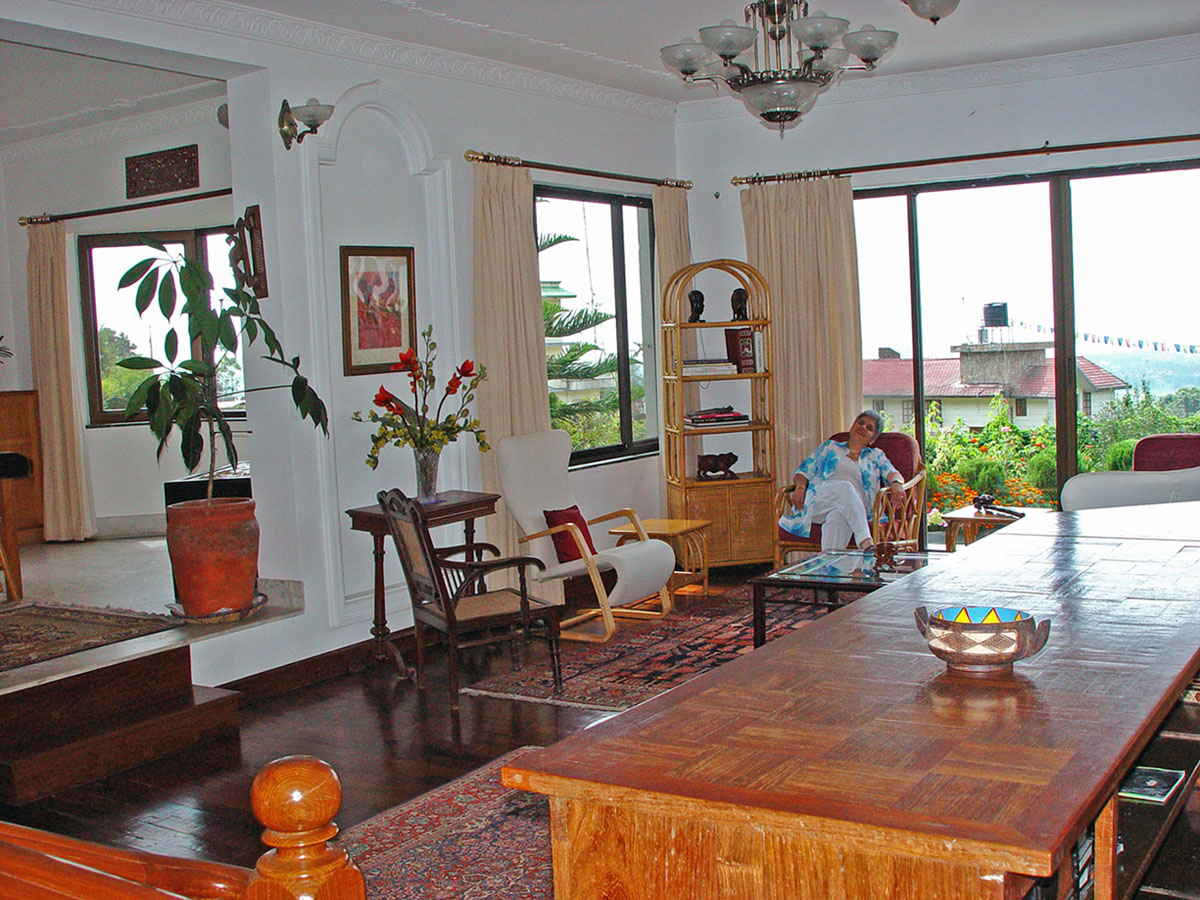
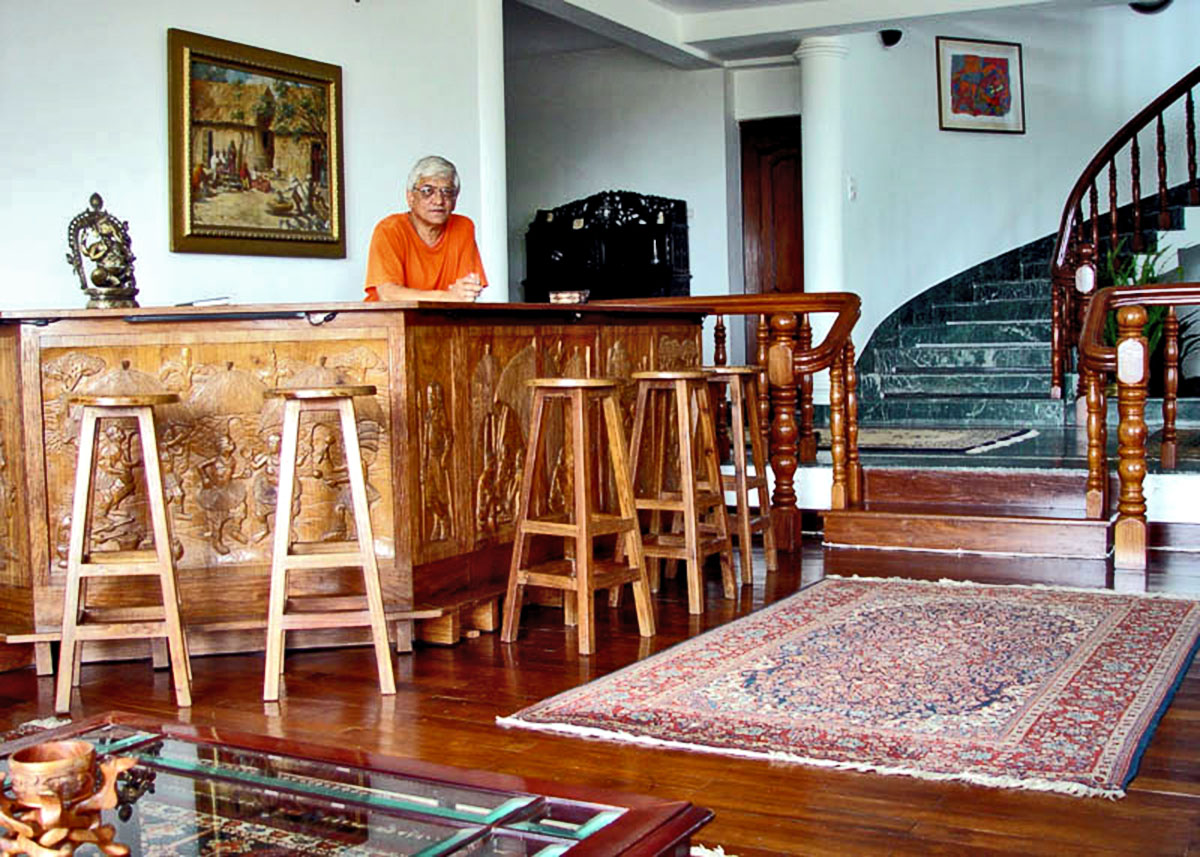 The
The
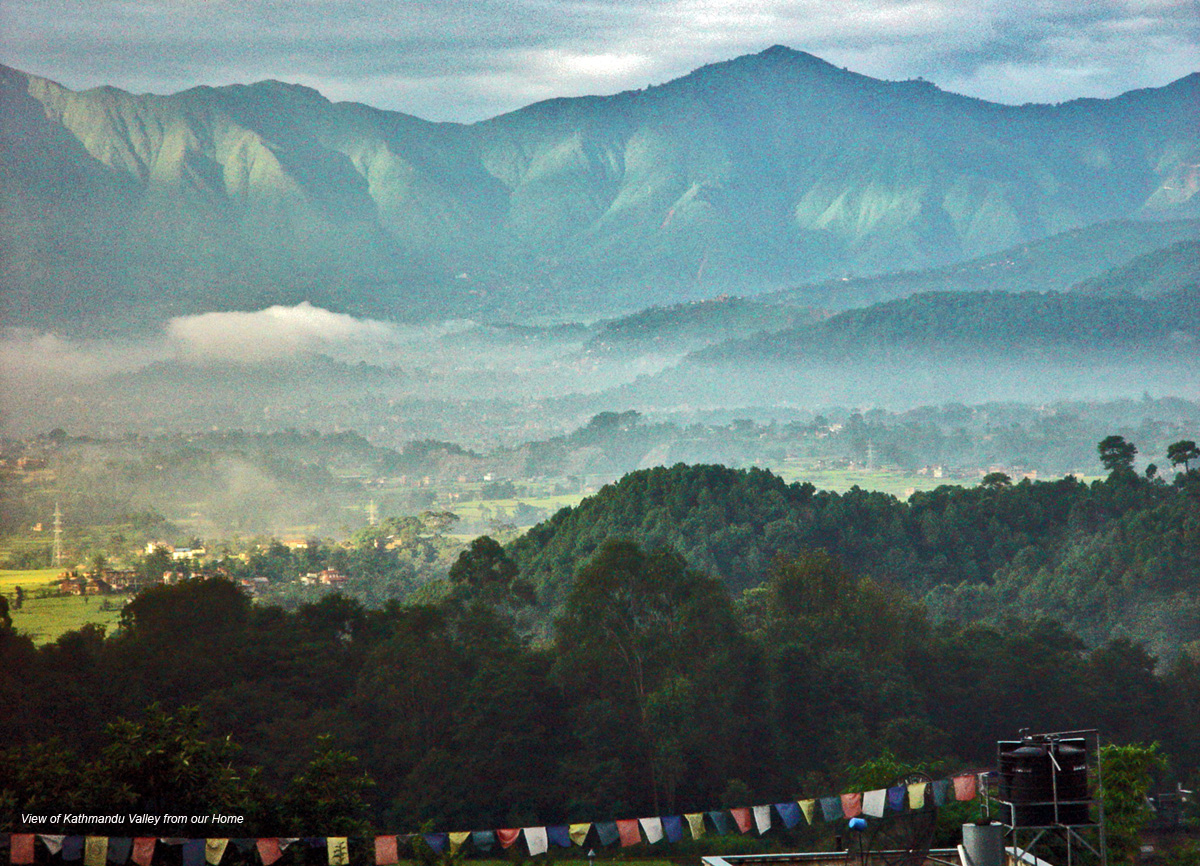
The house and garden lent themselves to entertaining and in the time we lived there, we hosted many enjoyable and memorable parties.
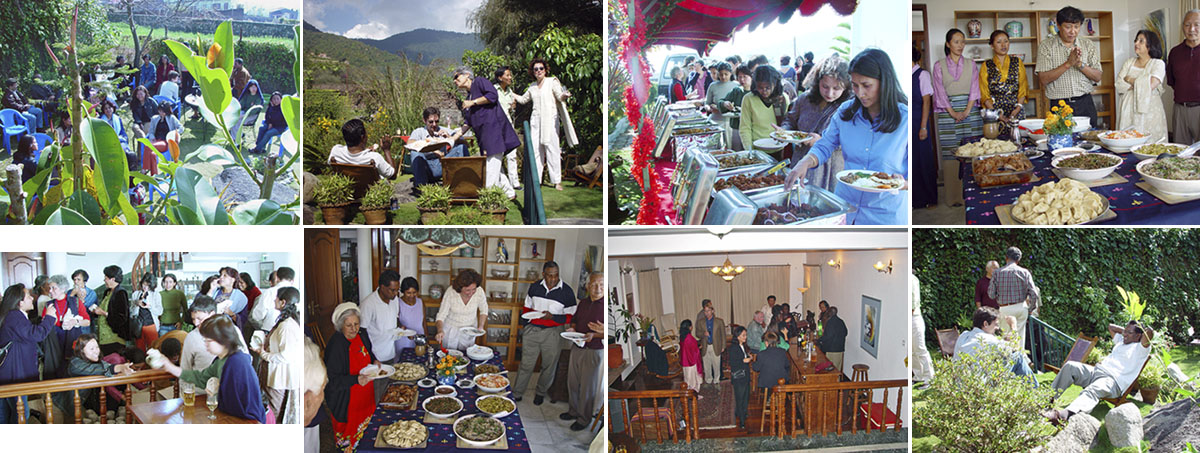
Soon after we moved into the house, we decided to have a Buddhist blessing ceremony, a puja. I went to the Shechen Monastery near the Bodhnath Stupa, one of Kathmandu’s most famous landmarks. I chose this monastery because it was Tibetan and we were familiar with their ethos and culture.
In 1980, Dilgo Khyentse Rinpoche began building Shechen Tennyi Dargyeling Monastery in the Kathmandu Valley. For almost ten years, master craftsmen, stonemasons, sculptors, painters, goldsmiths, and master tailors worked to make the monastery one of the most beautiful examples of Tibetan art. The walls of the main temple (now destroyed in the 2015 earthquakes) were covered with frescoes depicting the history of Tibetan Buddhism and the important teachers from its four main schools. The monastery has over one hundred and fifty statues and one of the largest Tibetan libraries in the East. - Shechen Monestary Website
I walked around the monastery, visited the main prayer hall, and admired the wonderful statues, frescoes, and thangkas. Not knowing how to proceed in my quest, I approached a young monk and asked him who I needed to talk to about a pooja at my house. He led me to an office and when I explained to the monk behind the desk what I was there for, he said “Oh my good lady, you are incredibly lucky! Our Rimpoche from Bhutan is here for just three days. He is on his way to the USA - I will ask him to do the pooja for your house, that will be a great blessing for you!”
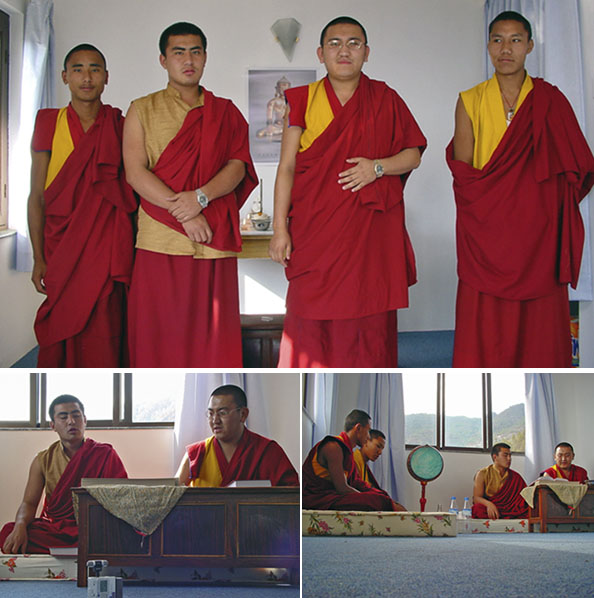
Rinpoche set everything up on the top floor because, he explained, the prayers and incense would then waft through the house and permeate every nook and corner.
The prayers began at 8.30 am and concluded at 4 pm with a short break for lunch. The pooja was mesmerizing and beautiful! The voices of the monks coupled with the instruments and the chanting, the comforting sunlight streaming in and the views from every window, made this a truly unforgettable experience. Sadly, I did not know anyone to invite to witness this wonderful pooja, and Rob was too busy at the office to get the time off all day, but he did catch the last hour of the ritual. Towards the end, Rinpoche asked Robert if there was any particular part of the house that he wanted blessed, and Rob led him to the garden and asked him to bless our water source. The Lama was delighted with this request and told us that in all the years he had been conducting blessings for homes, no one had ever asked him to bless a water source. Water after all, is vital to our existence and is the source of life!
While enjoying a cup of tea with the monks, we told Rinpoche that we had spent over 4 years in his native Bhutan, and he was delighted to hear this. He told us that he had been directed by the Dalai Lama to go to the USA to help people learn ways to deal with stress and to experience life as it should be lived, with joy!
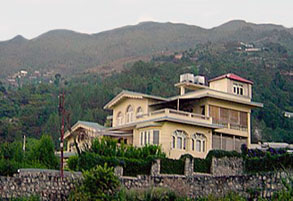 The day after the pooja, Rob and I were sitting in the garden when we saw a portly white man sitting on the ledge of his balcony in the house next to ours on the other side of the lane. He sported a bright orange T shirt, waved to us, and called out in an American accent “Welcome to the Neighbourhood! Can I send you anything?”
The day after the pooja, Rob and I were sitting in the garden when we saw a portly white man sitting on the ledge of his balcony in the house next to ours on the other side of the lane. He sported a bright orange T shirt, waved to us, and called out in an American accent “Welcome to the Neighbourhood! Can I send you anything?”
We later met Swami Chetananda, who headed the retreat center of the Nityananda Institute in Nepal. Their main interest was exploring the tantric traditions of spiritual practice in Asia, particularly the tradition of Kashmir Shaivism, which originated in northern India and made its way to Nepal - nityananda-institute.org
Swami Chetananda became a good friend and would occasionally walk over to visit. He loved to shoot the breeze with a glass or two of his favourite single malt whiskey. He is greatly revered by his followers and is also the leader of a large Ashram in Portland Oregon, where we visited him and were graciously hosted on one of our visits to the US
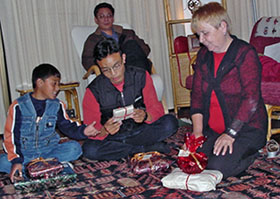
Swamiji lived to one side of us and on the other was Beatte, a German lady with green fingers! She had the most beautiful garden filled with vegetables and flowers and ran a rooftop restaurant overlooking the famous Bouda Stupa. Beate was a single mum and had been a pharmacist all her life. With her children grown up and independent, she retired and came to trek Nepal, fell in love with it and stayed on. She used her German pension to informally adopt two Tibetan children, Rindzin and Nyima who lived with her. They were in their late teens when we got to know them, and she paid all their expenses including their school fees. Beate was fluent in Nepali, a compassionate woman, a great neighbour and a wonderful friend.
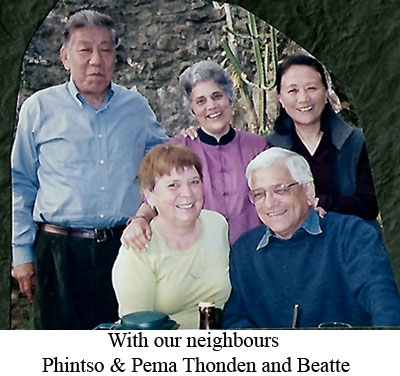
Below us was a house where a delightful elderly Tibetan couple, Pema & Phuntso Thobdin lived. They were retired and would spend six months in Budhanilkantha and six in New York. Below them lived Shakoon and her American husband John. Shakoon was Nepali, she owned a factory where she designed and produced the most beautiful Pashmina shawls for the European market.
We knew everyone in our neighbourhood and felt a great sense of community which extended to our farmer friends dotted around us. Our household help Kul Bahadur and our night guard Mr Tsering lived in homes above ours and our gardener, Kancha lived below us by the famous Vishnu temple.
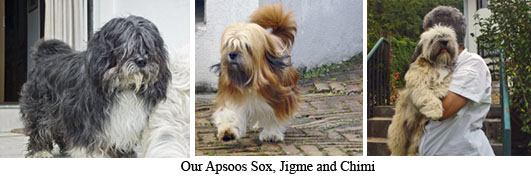
We adopted three beautiful Apsoos we named Sox, Jigme (both are the subjects of other stories) and Chimi.
Nepal was our last posting; Robert would soon be retiring after having served the organisation for 30 years in six countries. How fortunate we were to have started our international career with UNICEF in Bhutan, and ended it in Nepal!
It was a privilege and a blessing to have experienced and lived in both these countries which are endowed with unsurpassed natural beauty and unique and special cultures!
In May 2003 we retired to Kuala Lumpur to be on hand for my elderly parents, and we continue to enjoy living here in “Malaysia Truly Asia!”
Socrates (Sox)
by Hootoksi Tyabji, Kathmandu, 2003
Soon after we arrived in Kathmandu, I began scanning the notice boards for a dog that needed a home. Imagine my joy when I found this advertisement: ‘wanted a good home for a loving, black Apsoo male. Good with children and ready to move in immediately’.
 Robert and I love Apso's so I hot footed it over to the advertiser, an American couple, and was met at the gate by this blob of matted black fur with four white-tipped paws, a tail and a wet black nose! The owner was on his way to Zimbabwe and seemed anxious to hand the dog over to me, but I had a few questions. How old was this animal? Oh, about 7 or 8 (his vaccination booklet revealed he was 11!) Was he house trained? Well yes, kind of (we soon discovered he wasn’t and liked to lift his leg on furniture around our house!) Did he have any strange habits, any likes or dislikes? Not really, but he did have a colourful history and would I care to hear it? Here is what I learned…
Robert and I love Apso's so I hot footed it over to the advertiser, an American couple, and was met at the gate by this blob of matted black fur with four white-tipped paws, a tail and a wet black nose! The owner was on his way to Zimbabwe and seemed anxious to hand the dog over to me, but I had a few questions. How old was this animal? Oh, about 7 or 8 (his vaccination booklet revealed he was 11!) Was he house trained? Well yes, kind of (we soon discovered he wasn’t and liked to lift his leg on furniture around our house!) Did he have any strange habits, any likes or dislikes? Not really, but he did have a colourful history and would I care to hear it? Here is what I learned…
Many years ago, there lived a German gentleman in Kathmandu who owned and loved a black Apso dog. The two were inseparable and were seen together in the town’s markets and sometimes in bars and restaurants. The dog traveled frequently with his master to Germany. On one such occasion, customs officials detained the gentleman and searched the dog box, which turned out to have been stuffed with drugs! There was a law that said a passenger may not be arrested at the point of entry but should be returned to the country where he boarded the flight. So, the dog and German were sent back to Kathmandu and went straight into jail.
While they languished there, a kindhearted social worker doing her rounds of the jails, became upset when she saw them. Certainly, the man deserved to be there, but why the poor dog who had committed no crime? She had a female pooch at home and since the jailed beast was female too she decided she would take it home! Little Lucy was delighted to have a new friend and there would be no puppies to worry about so all was well!
The two animals adored each other and soon Lucy was glowing and putting on weight. Imagine her mistresses shock when the extra weight turned out to be puppies! How was this possible, since Lucy never left the house and no male dog was ever let in! This could only mean an Immaculate Conception had occurred! But that did not happen in real life, so the vet was called in. After a long, close and through examination it was discovered that the dog from jail was a hermaphrodite. This is rare but even more so is that this hermaphrodite dog fathered puppies and the old dog Socrates who we were about to adopt, was one of those puppies!

Sox at home in Budhanilkantha
The Family Next Door
by Hootoksi Tyabji, Kathmandu, May 2001
Kathmandu was our last posting with UNICEF, and we rented a home in a wonderful part of town called Budhanilkantha, looking southward over the Kathmandu valley.
Ours was a community of different economic backgrounds; some of us lived in mansions and went to work in cars, others lived in small huts and worked the land, growing vegetables rice, maize and wheat.
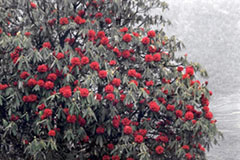 One evening soon after we moved into our home and before our shipment had arrived from Dar es Salaam, Rob and I decided to go for a walk to explore the neighborhood. Two young boys joined us along the way chatting in perfect English and one of them said, "Do you want to see the rhododendrons blooming?" We certainly did and eagerly followed them up the mountain to a riot of red, a place we would never have found on our own. Sunil and Prem were around 8 and 10 years old and went to an English medium school down the road from where we lived.
One evening soon after we moved into our home and before our shipment had arrived from Dar es Salaam, Rob and I decided to go for a walk to explore the neighborhood. Two young boys joined us along the way chatting in perfect English and one of them said, "Do you want to see the rhododendrons blooming?" We certainly did and eagerly followed them up the mountain to a riot of red, a place we would never have found on our own. Sunil and Prem were around 8 and 10 years old and went to an English medium school down the road from where we lived.  On the way back, they insisted we stop over at their house for tea. Their home was a beautiful traditional Nepali house set in a field of corn. We sat on a charpoy in the courtyard looking down into the valley and watching the shadows lengthen as we sipped tea served by sister Manju, while the boys told us their story.
On the way back, they insisted we stop over at their house for tea. Their home was a beautiful traditional Nepali house set in a field of corn. We sat on a charpoy in the courtyard looking down into the valley and watching the shadows lengthen as we sipped tea served by sister Manju, while the boys told us their story.
The family consisted of Sunil & Prem, an older brother, and their two older sisters Manju (16) and Nita (14). The children seemed to have to fend for themselves as there were no adults around. Their father had left to work in Saudi Arabia ten years ago and had not been heard of since, and their mother worked as a housemaid in town and only came home to the children once a month.
Manju took over the mantle of her mother, cooking, cleaning, washing the clothes and keeping the fields going with some help from grandpa whenever he could come from his village half a day's walk away.
The family had been converted to Christianity and this assured an English medium schooling for the two boys and a roof over their heads for the family. The church had built the house that they lived in on land that they owned. Though there was a picture of Jesus Christ on the wall in the main room, Manju said she still felt Hindu in her heart.
While the boys clearly had the advantage of schooling, we felt sad for Manju and asked her if she would like to attend school as well. She vehemently shook her head, and Prem piped up, "Why should she go to school, she's only a girl. No need for her to study!" We soon set him right on that score!
Manju said that she would like to earn some money cooking for someone but she would never get the chance because she only knew how to cook very simple Nepali food! I invited her to come over to cook and learn some new recipes from me, she was delighted and we said goodbye to the first friends we made in our neighborhood!
Manju was very nervous on her first visit to our home. She had never seen such a grand kitchen and had no idea how to use a cooking range or an over but she was a quick learner and produced a simple but delicious Nepali meal for which she earned her own money.
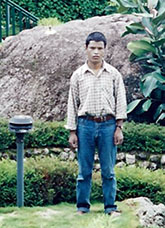 Later in the afternoon I was working on my computer when there was a knock on the door. It was Kul Bahadur, our helper looking very officious with his hands folded across his chest and an angry expression on his face. He was clearly upset!
Later in the afternoon I was working on my computer when there was a knock on the door. It was Kul Bahadur, our helper looking very officious with his hands folded across his chest and an angry expression on his face. He was clearly upset!
Kul Bahadur also lived in Budhanilkantha, in fact we could see his house in the distance above ours. He had been hired by our landlady as a security guard and when we rented the house, he approached me and said he wanted to work for me, to do the cleaning and take care of the place. When I asked him what his previous job had been, he said he was a porter for the army carrying sacks of grain up and down the mountains. He had never worked in a house but was confident he could learn on the job if I would teach him. We decided to give him a chance, and he was delighted and was a quick learner.
That afternoon he took a rather aggressive stance in front of me, cleared his throat and began to speak "That woman you have just let into your house, do you know who she is? She is an untouchable. She has defiled your kitchen and the whole house. Do you expect me to clean the things she has touched? I would rather die than do that. If you allow her into your house again, I will have to leave, I cannot work here."
So there it was, surfaced again, the age old ridiculous caste system which I thought had been put behind us! I sat Kul Bahadur down and had a long chat with him. I told him how all human beings are equal in the eyes of God, I talked about Gandhiji and the reforms he had made, I tried to make him understand how unjust the whole caste concept was. I implored him to think for himself and to teach his children not to accept the bizarre notion of untouchability. He listened to everything I had to say and then he simply said “I live in this village and I obey the rules of my village. If you allow that girl in this house, I will have to leave. You must choose.”
I knew Kul Bahadur was confused and upset so I urged him not to make a decision he would clearly regret, right away. I told him Manju and her family would always be welcome in our home as was he and his family. I asked him to take some time to think things through.
Ten days later he came to me with a big smile and he said “I have made my decision. I will continue to work for you, the pay is good, and my family is benefiting. I spoke to the village headman and he said it was alright for me to be in the same house as that girl because you are foreigners and do not know any better.”
We never spoke about this again and Manju and her bothers continued to come to visit our home. Kul Bahadur accepted their visits and even washed the dishes that she had handled, a first for him!
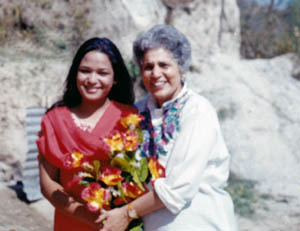 At Xmas we had presents around the tree for all the children and as they filed past collecting theirs, Manju handed me a little parcel. I was delighted and asked her if I could open it. Inside was a small cloth bag that she had made for me. I gave her a hug and as she walked away, I noticed that she had cut the fabric for the bag out of her best blouse, for me. That is one of the most precious gifts I own.
At Xmas we had presents around the tree for all the children and as they filed past collecting theirs, Manju handed me a little parcel. I was delighted and asked her if I could open it. Inside was a small cloth bag that she had made for me. I gave her a hug and as she walked away, I noticed that she had cut the fabric for the bag out of her best blouse, for me. That is one of the most precious gifts I own.
This incident occurred in 2001. In early 2008, Kul Bahadur (who joined us in Malaysia) proudly announced that the government of the new Republic of Nepal had just outlawed the age-old caste laws and had declared equality in all respects between the sexes.
The Royal Massacre
Robert Tyabji, Kathmandu, 2002 and 2020
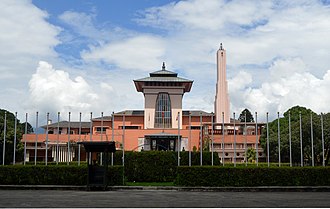 At 5 am on the 2’nd of June 2001, Hootoksi and I were awakened by the phone. It was a friend in Kathmandu who in an agitated voice said that the royal family had been wiped out by gunfire inside the Narayanhiti royal palace at dinner time, and that we should remain home because there were certain to be riots in the streets.
At 5 am on the 2’nd of June 2001, Hootoksi and I were awakened by the phone. It was a friend in Kathmandu who in an agitated voice said that the royal family had been wiped out by gunfire inside the Narayanhiti royal palace at dinner time, and that we should remain home because there were certain to be riots in the streets.
This came as a huge shock to us as we had driven right by the palace walls that very night, perhaps just as the massacre was taking place! The Nepali royal family was widely loved and had an unshaken, largely popular reign of 240 years. In spite of the often violent Maoist insurgency, Nepal was a peace-loving Hindu country with a large Buddhist minority. Besides, we had been secure in the belief that after Yemen our exposure to turmoil, violence and death was over once and for all.
As the day wore on, we were able to learn more about what had happened. I also learned that hordes of young men were roaming the streets in pickups, their heads shaven in mourning, ordering people to go home.
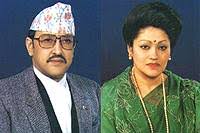 On the evening of Friday, 1 June 2001, when the Royal Family was seated at their customary weekend dinner, Crown Prince Dipendra allegedly opened fire, killing his father, King Birendra, his mother, Queen Aishwarya (photo), his only brother and sister, and five other members of the royal family before allegedly shooting himself in the head. Due to his wiping out of most of the line of succession, he was crowned king while in a comatose state from the head wound.
On the evening of Friday, 1 June 2001, when the Royal Family was seated at their customary weekend dinner, Crown Prince Dipendra allegedly opened fire, killing his father, King Birendra, his mother, Queen Aishwarya (photo), his only brother and sister, and five other members of the royal family before allegedly shooting himself in the head. Due to his wiping out of most of the line of succession, he was crowned king while in a comatose state from the head wound.
This was not the first time in Nepal's history that such a dreadful event took place. On the night of 14 September 1846, an even more ghastly massacre took place near the same Royal Palace. A large number of the kingdom's notables were killed by a young army captain Jung Bahadur Rana, with the aid of his brother, who later usurped prime ministerial powers, rendering the king into a figurehead. This was the beginning of the authoritarian rule of the Rana family for the next 104 years. It was only in 1950-51 that King Tribhuvan was able to liberate his monarchy and plant the beginnings of multi-party democracy in Nepal.
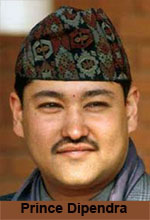 Prince Dipendra's motive for the murders is unknown, but there are various theories. Dipendra desired to marry Devyani Rana whom he had met in the United Kingdom. Some allege that, due to her mother's family being lower-class royals of India and her father's political alliances, Dipendra's parents objected. (Actually, Devyani Rana's Gwalior family is one of the wealthiest former royal families of India, and allegedly far wealthier than the Shahs of Nepal.) Dipendra's prospective bride descended, through her mother, from a competing sub-branch of the Nepali Rana clan (the Juddha Shamsher line) to that of Queen Aishwarya.
Prince Dipendra's motive for the murders is unknown, but there are various theories. Dipendra desired to marry Devyani Rana whom he had met in the United Kingdom. Some allege that, due to her mother's family being lower-class royals of India and her father's political alliances, Dipendra's parents objected. (Actually, Devyani Rana's Gwalior family is one of the wealthiest former royal families of India, and allegedly far wealthier than the Shahs of Nepal.) Dipendra's prospective bride descended, through her mother, from a competing sub-branch of the Nepali Rana clan (the Juddha Shamsher line) to that of Queen Aishwarya.
Another theory states that there was a possibility of greater Indian influence in Nepal if he married her, a notion unpalatable to the palace. Other theories allege that Dipendra was unhappy with the country's shift from an absolute to a constitutional monarchy and that too much power had been given away following the 1990 People’s Movement. This is, in fact, unlikely as the crown prince had responded to the 1990 uprising, and return to an elected government, with enthusiasm while a student at Eton College, where he was finishing his studies. He later became frustrated by his father's refusal to intervene while the Nepali politicians bickered and competed among themselves while failing to make an effective response to the rising Maoist threat.
However, none of these theories explain what could possibly cause a Hindu son to murder his parents in cold blood, even if, as alleged, he was high on drugs.
Much controversy surrounds the circumstances of the massacre, and even today, with the monarchy abolished, many questions remain within Nepal about its cause. Sources of the yet unanswered questions include details such as the apparent lack of security at the event; the absence from the party of Prince Gyanendra, Dipendra's uncle who succeeded him; the fact that, despite being right-handed, Dipendra's self-inflicted head-wound was located at his left temple, and that two bullets were found to be lodged in the temple instead of one; and finally that the subsequent investigation lasted for only two weeks and did not involve any major forensic analysis. This investigation was done after Scotland Yard had actually offered to carry out a forensic investigation.
Other theories abounded. There is a belief that a mystic had predicted the demise of the 240-year-old ruling dynasty, based on his astrological calculations. He is believed to have predicted that the dynasty would end in 12 generations.
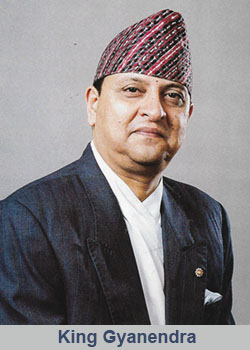 Dipendra was proclaimed king while in a coma, but he died on 4 June 2001, after a three-day reign. His uncle Gyanendra was appointed regent for the three days, then ascended the throne himself after Dipendra died. The crowning seemed to many observers to confirm the worst of the rumors. The new King had a heavy agenda on his table. Nepal was wracked by Maoist insurgency and these events gave it renewed momentum, and in the ensuing years Gyanendra's rule became increasingly unpopular, especially after the king sacked the prime minister in 2002. (some of the above is based on public reports and an article by Arvinda R Deo, former Indian Ambassador to Nepal, which was published in The Economic Times)
Dipendra was proclaimed king while in a coma, but he died on 4 June 2001, after a three-day reign. His uncle Gyanendra was appointed regent for the three days, then ascended the throne himself after Dipendra died. The crowning seemed to many observers to confirm the worst of the rumors. The new King had a heavy agenda on his table. Nepal was wracked by Maoist insurgency and these events gave it renewed momentum, and in the ensuing years Gyanendra's rule became increasingly unpopular, especially after the king sacked the prime minister in 2002. (some of the above is based on public reports and an article by Arvinda R Deo, former Indian Ambassador to Nepal, which was published in The Economic Times)
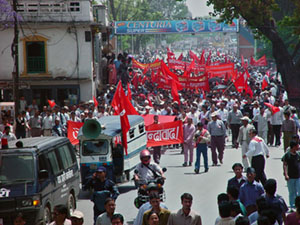 Cries to establish a republic in Nepal grew progressively louder. Abolition of the monarchy was a sworn goal of the Maoist armed insurgency (CPN-M) that had plagued the country since 1996. Nevertheless, in 2008 the Maoists won the largest voting bloc in the Nepalese Constituent Assembly and have since effected many needed social and economic reforms. The historic declaration of the Republic of Nepal is the culmination of years of turmoil, struggle and oppression of the Nepali people by Maoist fighters on the one hand and the royalty-backed army on the other.
Cries to establish a republic in Nepal grew progressively louder. Abolition of the monarchy was a sworn goal of the Maoist armed insurgency (CPN-M) that had plagued the country since 1996. Nevertheless, in 2008 the Maoists won the largest voting bloc in the Nepalese Constituent Assembly and have since effected many needed social and economic reforms. The historic declaration of the Republic of Nepal is the culmination of years of turmoil, struggle and oppression of the Nepali people by Maoist fighters on the one hand and the royalty-backed army on the other.
Photo: All-Party rally, Kathmandu, May 2003
We lived in Nepal in our final years with UNICEF and experienced these tumultuous developments at first hand. We have visited the homes of the well-to-do and successful but have also observed the struggles of poor Nepalis in the towns and villages. Trekking through deep snow on the slopes of Annapurna, columns of Sherpa porters have passed us wearing nothing but rubber slippers and threadbare sweaters, each hauling 40 kilo loads of beer, gas cylinders and other tourist necessities. We have seen news reports of public buses blown to pieces because some of the passengers were assumed to be young men and women fleeing the Maoist recruitment drives. Hootoksi has spent months working directly with the poorest of women and children in Kathmandu's industrial areas and outlying villages. So, we understood the pain of the Nepali people and have sympathized with their hopes and dreams. Our sincerest and warmest best wishes to the people of the Republic of Nepal!
Letter to Jigme
Hootoksi Tyabji, En route from Hille Koshi to Kathmandu, April 2003
Robert retired from UNICEF having served for 30 years, Nepal was our last posting and we had decided to retire in Malaysia where my parents lived.

The hardest part of the move was having to leave my beloved dog Jigme behind. Fortunately, we found a wonderful home for him with friends on a tea plantation in Hille Koshi in eastern Nepal. Andrew and Anu were dog lovers, they had two dogs on the plantation and Jigme with his fluffy coat would be a lot more comfortable in the cool climes of Nepal than in Malaysia; but the pain of separation was intense and I was beside myself at the parting, so Robert decided to take a detour and drive through the Koshi Tappu wild life forest reserve to calm me down and cheer me up.
 Just as we got out of the car, there was this lump of fur on the lawn in front of us. It was a baby Albino fawn. Some people had found it abandoned in the forest just minutes before we arrived. I have no words to describe my feelings as I held its trembling body in my arms and loved it for just a few moments in time, and it was just the balm I needed for my pain.
Just as we got out of the car, there was this lump of fur on the lawn in front of us. It was a baby Albino fawn. Some people had found it abandoned in the forest just minutes before we arrived. I have no words to describe my feelings as I held its trembling body in my arms and loved it for just a few moments in time, and it was just the balm I needed for my pain.
This letter was written to express my feelings on having to part with Jigme. He was the love of my life and parting with him was yet another lesson in life and living!
17th April 2003 Royal Park Hotel, Royal Chitwan National Park, Nepal
Darling Jigme,
Just to let you know that last night we checked into a beautiful place, the Royal Park Hotel which is just outside the Chitwan National Park.
It is 5 AM and I am sitting on the balcony looking out on the beautiful garden and listening to the cacophony of a host of birds each trying to outdo the other with a warble, a song, a call or a trill!
Most people would find this crazy, writing a letter to a dog, but that is because they have never been fortunate enough to communicate with living beings outside the scope of the human form. To them the notion is “ridiculous”, but you and I know better, for we feel each other’s joy and pain and presence.
Parting with you was a test for me and tangible proof that attachment causes sorrow. Yet, I could not let you go………..but I knew I had to leave you with the Gardeners in Hile because you are happy there and they all love you as we do! Andrew will take you to bed with him if Anu allows it Anouksha and Akshath will fuss over you and brush you when they are home from boarding school. I have told them you enjoy that brush with the pokey bristles especially on your tummy and under your chin. Narbada and Shakuntala will feed you well and Bud and Sparkle will eventually include you into their gang. Watch out for Bud, he is teething, and Sparkle might get jealous now and again. The cool, fresh mountain air will sooth and comfort you and every time you feel the soft caress of the wind on your beautiful face, it’s me come to kiss you.
Yesterday on our way here we stopped off at Koshi Tappu, a Wetlands Reserve and home to many exotic plants and species of birds, fowl and beast. There have been sightings of dolphins in the river and we hoped to see some. The boat was there but the boatman was missing so we were not permitted to leave. My heart was heavy, I was missing you so much focusing only on your fluffy cuteness and missing out on the beauty of my surroundings; and then right there before me was this white ball of fur on the lawn. What was it? Just the night before, a shepherd found a day-old Albino fawn abandoned by its mother. He brought it to the Sanctuary and as I held it in my arms it closed its pink eyes and seemed so completely at peace. I held it close and then I gently laid it on the ground. It was wobbly on its long delicate legs which could not support it properly, so it just folded them under its body and curled up to sleep - a bundle of white fur. Alone and seemingly content.
We drove on, along the East – West Highway. On three occasions we found ourselves behind trucks carrying water buffaloes to the slaughter. What magnificent beasts they are! They stood tall and proud even though they were tethered with ropes that were mercilessly drawn through their flared nostrils! They held their heads high and one old beast had the most beautiful horns that stood out on his head like the branches of a tree! They had this plaintive, expressive, faraway look, accepting and content.
The Buffalo, the baby deer and you live each moment of your lives in the present and reflect the majesty and might of the Great Spirit that dwells within you. That same Great Spirit abiding in me and every other sentient being has once again set me free, to feel and experience the power of Love – shining, living, pulsating, being, beating, living, dying, Everywhere, everyplace, all the time, eternally….
And you and I, the fawn and the buffalo, the birds and the trees, the mountains and the seas, the good and the bad, the meetings and the partings are no more than a flash in the realm of time which is eternal.
Love abounds everywhere, everyplace, all the time, eternally in every living thing – I know this and feel it again. I feel joyful and at peace. How can I lose you when you live with me in my heart?
We're leaving Nepal and heading for Malaysia!
